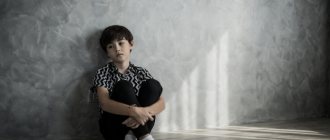— Advertising —
Increased anxiety in a child is the second most common group among children’s mental problems (behavioral disorders take the lead). Its clinical signs are observed in approximately 8% of children. Unfortunately, this figure is growing. Therefore, we have prepared a short guide for those parents who are concerned about preventing or reducing anxiety in their child.
What is increased anxiety
Fear is an annoying but indispensable companion in human life. It is “hardwired” into our instincts and is triggered as part of a survival mechanism. A.I. Zakharov, one of the leading experts in the field of childhood neuroses, describes the dynamics of the emergence of fears:
| Child's age | Fears at this age |
| from 1 to 3 years | fear of unexpected sounds, darkness and pain |
| from 3-15 years | fear of loneliness and closed space |
| from 5 to 7 years | fear of death |
| from 7 to 11 years | fear of other people's assessments, when children begin to be afraid of “not being the one who is respected, appreciated and understood” |
How can you determine that your child’s anxiety level has gone beyond the normal range and turned into an anxiety disorder?
Normal anxiety is episodic manifestations of fear. They are always caused by specific circumstances. Increased anxiety, on the contrary, is a clinically stable condition. It is present in the background.
In other words, any child can suddenly become agitated if you put him on a stool and ask him to sing in front of an unfamiliar audience, but in most life situations he will be calm and joyful. A child with increased anxiety can rarely relax and experiences anxiety almost constantly: when left alone, when going to a noisy holiday, or when responding to a stranger.
Fears are gender dependent. Before the age of 12, they are more disturbing to boys, and after 12 years - to girls.
Types of anxiety in children
Separation anxiety
The baby gets upset and worries a lot when mom or dad leave. The grown-up child refuses to go to kindergarten or stay with his grandmother. Separation anxiety begins to appear at 9 months and can worsen at 2-3 years.
Social anxiety in children
The child feels discomfort in the presence of a large number of people, is afraid of being judged, and cannot stand noisy places. Social anxiety often arises due to a lack of understanding of an object or event, as well as a lack of experience in the child.
Anxiety-phobic disorder
A hidden, irrational fear of certain things or situations. For example, fear of thunderstorms, insects, closed spaces.
Symptoms of increased anxiety in a child
Most anxious children at an early age simply cannot explain their problems, and in adolescence they persistently deny them. Therefore, it is important to notice the first somatic signs in time. Here is a short list of them (without classification into different types of anxiety disorders):
- hot flashes or chills;
- tremor or shaking;
- cardiopalmus;
- chest discomfort or pain;
- feeling of a lump in the throat;
- difficulty breathing;
- fainting or dizziness;
- muscle tension;
- numbness or tingling;
- feeling of “emptiness in the head”;
- a feeling of the unreality of objects or the separation of one’s own “I”.
Then double-check your observations using the questionnaire (authors Lavrentyeva G.P. and Titarenko T.M.), where each positive answer will be counted as 1 point:
- Your child cannot work for a long time without getting tired;
- He has difficulty concentrating;
- Any task causes unnecessary anxiety;
- Very tense and constrained while performing tasks;
- Feels embarrassed more often than others;
- Often talks about tense situations;
- Typically turns red or pale in unfamiliar surroundings;
- He complains that he has terrible dreams;
- His hands are usually cold and damp;
- Often suffers from stool disorders;
- sweats a lot when excited;
- Does not have a good appetite;
- Has difficulty falling asleep, sleeps restlessly;
- He is timid and fears many things;
- Usually restless, easily upset;
- Often cannot hold back tears;
- Does not tolerate waiting well;
- Does not like to take on new business;
- Not confident in himself and his abilities;
- Afraid to face difficulties.
If the total number of points reaches 15-20 points, then your child has increased anxiety; 7-14 points - average; 1-6 points - low.
Having received a sad verdict, do not panic. Unlike behavioral disorders, anxiety in children tends to subside as they get older. However, you shouldn’t turn a blind eye to it on the principle that “it will go away on its own.” According to experts, children with increased anxiety are at risk. A small proportion will continue to have anxiety disorder in adulthood, and some will develop depressive states. There is no need to explain how this will affect their success in life.
Prevention of increased anxiety or 10 “don’ts”
Threaten the child with impossible punishments (“I’m ready to kill you”) or excommunication from the family (“I’ll give you to the gray wolf, and I’ll take a good boy for myself”). Remember that for the baby you are omnipotent, and he is absolutely sure that you are able to carry out any threat. Threaten the child with impossible punishments (“I’m ready to kill you”) or excommunication from the family (“I’ll give you to the gray wolf, and I’ll take a good boy for myself”). Remember that for the baby you are omnipotent, and he is absolutely sure that you are able to carry out any threat.
- Threaten the child with impossible punishments (“I’m ready to kill you”) or excommunication from the family (“I’ll give you to the gray wolf, and I’ll take a good boy for myself”). Remember that for the baby you are omnipotent, and he is absolutely sure that you are able to carry out any threat.
- Yelling at a child, especially in the presence of other people.
- Use language that humiliates the child or lowers his self-esteem.
- Compare him with other children, both in good and bad behavior.
- Continuously criticize. Do an experiment. Write down every comment you make to your child during the day, and re-read the list before bed. Most of them will turn out to be of the same type and petty, did not bring any benefit and only damaged your relationship.
- Make excessive demands without taking into account the individual characteristics of the child.
- Demand an apology for any wrongdoing. Sometimes it is more useful for the child to honestly explain his reason.
- Requires courage. Take your time and give your child time to get used to the new situation and people.
- Force them to compete with other children. Especially in games where speed in completing tasks is required.
- Undermine the authority of other significant adults. (“Just listen to me! Your teachers don’t understand anything!”)
Recommendations for reducing anxiety or 10 “musts”
If you notice signs of anxiety in your child, make every effort to correct your behavior.
- Call your child by name often and maintain eye contact when speaking.
- Increase the number of tactile contacts. Affectionate touches help restore trust in the world.
- Celebrate his successes often and preferably publicly (for example, at a family dinner). Remember that there is always a reason for praise. It is enough to notice the little things that your child does better than yesterday.
- Organize parties at home and invite your classmates to them. Even your presence in another room will have a beneficial effect on an anxious child. He will feel more confident than all alone at school, and this will gradually change the opinion of his peers about him. Believe me, this is extremely important for him, even if he doesn’t admit it.
- Be consistent with rewards and punishments. Imagine how disoriented and frightened your child is if yesterday you only glanced at the half-eaten porridge, and today you shouted for the same thing.
- Follow your own rules and do not forbid your child, without a valid explanation, to do something that he was previously allowed to do.
- Achieve unanimity in requirements with your spouse and other adults who make up your child’s immediate environment.
- Set an example of positive expectations for the future and demonstrate confident behavior.
- Discuss learning and communication difficulties with your child, and jointly develop a strategy for moving towards success.
- And the most important thing. If you are unable to maintain the desired line of behavior (especially repeating “10 is not allowed”), then seek help from a professional psychologist. The time has come to deal with the “ghosts” of your own childhood. At least for the sake of your child.
Rimma Kazantseva
Illustrations: Yulia Prososova
Anxious child. How to help a preschooler manage his behavior
Svetlana Ivakhova
Anxious child. How to help a preschooler manage his behavior
What is anxiety ? How to raise anxious children ? This article discusses the main factors that contribute to the development of anxiety in a child , practical recommendations for parents of a preschooler whose anxiety prevents him from feeling comfortable and developing all his inclinations .
Anxiety is an individual psychological feature consisting in an increased tendency to experience anxiety in a wide variety of life situations, including when there is no reason to worry (psychological dictionary)
.
Physiological signs of anxiety are rapid heartbeat, shallow breathing , dry mouth, lump in the throat, and weakness in the legs. However, in addition to physiological ones, there are also behavioral signs of anxiety : the child begins to chew his legs, rock on a chair, drum his fingers on the table, pull his hair, twirl various objects in his hands, etc.
The state of anxiety cannot always be regarded as a negative state. Sometimes it is anxiety that causes the mobilization of potential capabilities. Thus, when running away from a pursuer, a person develops a speed much higher than in a normal, calm state.
Among the emotions included in the state of anxiety , the key one is fear, although in “ anxious ”
the experience may include sadness, shame, guilt, etc. The emotion of fear is experienced by people at any age, but so-called
“age-related fears”
.
Research shows that the first manifestations of fear are observed in children already in infancy. In the period from two to three years, there is an expansion in the repertoire of children's fears, and, as a rule, they are of a specific nature.
At two years old, children are most often afraid, for example, of visiting a doctor, and starting from about three years of age, the number of specific fears decreases significantly, and they are replaced by symbolic fears, such as the fear of darkness and loneliness. At 6 - 7 years old, the fear of one's own death becomes the leading one, and at 7 - 8 years old - the fear of the death of parents. From 7 to 11 years old, the child is most afraid of “being the wrong one”
, do something wrong, do not comply with generally accepted requirements and standards.
Thus, the presence of fears in a child is the norm , but if there are a lot of fears, then we should already talk about the presence of anxiety in the child’s character .
Most often anxiety develops when the child is in a state (situation)
internal conflict. It can be caused by:
1. Negative demands placed on the child , which can humiliate or put in a dependent position;
2. Inadequate, most often inflated demands;
3. Conflicting demands that parents , kindergarten, and school place on the child.
4. Heredity: anxious parents are more likely to have anxious children . Moreover, this happens not only through the transmission of genes, but also through imitation of adults in the family, through the adoption of their way of thinking and behavior .
5. The situation in the family, most often a violation of relationships with parents, contributes to the emergence, increase and consolidation of anxiety :
1) excessive demands on the child ( “You should only get straight A’s”
);
2) conflict atmosphere in the family (if spouses quarrel among themselves)
;
An anxious child typically has most of the following characteristics: any task or new event makes him anxious; when performing tasks or when trying to control one’s anxiety, one is often tense and constrained (muscle tension is felt even in the face and neck)
;
sleeps restlessly, complains of terrible dreams; his attention is not impaired, but it is difficult for him to concentrate on anything when he is worried; does not tolerate situations of uncertainty or expectation; not confident in himself or his abilities , expects failures in his activities; tries to hide his problems and anxiety .
Quite often, anxious children have low self-esteem, which is expressed in a painful perception of criticism from others, blaming themselves for many failures, and fear of taking on a new difficult task. Such children, as a rule, are more likely than others to be manipulated by adults and peers. In addition, in order to grow in their own eyes, anxious children sometimes like to criticize others.
work with anxious children in three main areas:
• firstly, to increase the child's ;
• secondly, to teach the child ways to relieve muscle and emotional tension;
• thirdly, to develop self-control skills in situations that traumatize the child .
In order to help your child increase his self-esteem, you can use the following methods:
the child as often as possible and praise him in the presence of other children and adults. In kindergarten, for this purpose, you can celebrate the child’s on specially designed stands ( “Our successes”
,
“We can do this
,” reward
a child , participate in competitions, collect a preschooler’s .
— You cannot compare the results of these children’s tasks with other children. When communicating with an anxious child , this method of comparison is not acceptable. If you do make a comparison, then it is better to compare the child’s with his own results, which he achieved yesterday, a week, a month ago.
— When working with children suffering from low self-esteem, it is advisable to avoid tasks that are completed in a certain fixed time. Such children should not be rushed or pushed to answer. If an adult has already asked a question, he should give the child time to answer , trying not to repeat the question twice. Otherwise, the child will not answer quickly , since he will perceive each repetition of the question as a new stimulus.
— If an adult addresses an anxious child , he should try to establish visual contact, such direct communication “eye to eye”
instills a sense of trust in
the child's .
Working to increase self-esteem is only one of the areas in working with an anxious child . You cannot expect quick results from such work, so you need to be patient.
Teaching your child ways to relieve muscle and emotional tension.
Emotional tension anxious children most often manifests itself in muscle tension in the face and neck. In addition, they tend to tighten their abdominal muscles. To help children reduce tension—both muscular and emotional—you can teach them to do relaxation exercises .
In addition to relaxation games, it is also necessary to use games that are based on physical contact with the child . Playing with sand, clay, water, and various techniques for painting with paints (fingers, palms )
.
Using elements of massage and even simple rubbing of the body also helps relieve muscle tension. In this case, it is not necessary to seek the help of medical specialists. The mother can apply the simplest elements of massage herself or simply hug the child .
Game “Good - Evil, Cheerful - Sad”
(using the example of the fairy tale
“The Adventures of Pinocchio”
)
Purpose: The game helps to relax the facial muscles.
Content: an adult invites the child to remember the heroes of his favorite fairy tales. Then he asks to answer the following questions: “Which of these heroes is the kindest? Who's the meanest? Who's the funniest? Who's the saddest? What other heroes do you know (surprised, frightened? Then the child draws all the named characters on a piece of paper. After this, the adult says: “I’ll now try to make a guess for one of these heroes and show you how he looks. And you guess, who is this?" The adult makes a cheerful expression on his face. The child guesses which of the drawn characters is like this. Then the child depicts the facial expression of any character, and the adult guesses who it is.
The next stage in working with an anxious child is to practice self-control in situations that are traumatic and unfamiliar to the child . Even if work has already been done to increase a child’s and teach him how to reduce muscle and emotional tension, there is no guarantee that if he finds himself in a real-life unexpected situation, the child will behave adequately. At any moment, such a child may become confused and forget everything he has been taught. That is why practicing behavioral in specific situations is considered a necessary part of working with anxious children . This work consists of playing out both situations that have already occurred and those that are possible in the future. The most extensive opportunities in this direction are provided by role-playing games. By playing the role of weak, cowardly characters, the child is better aware and concretizes his fear. And using the technique of bringing this role to the point of absurdity, the adult helps the child see his fear from the other side, sometimes comical, in relation to him as less significant.
By playing the roles of strong heroes, the child gains a sense of confidence that he (like his hero)
able to cope with difficulties.
At the same time, it is very important not only to develop the game situation, but also to discuss with the child how he can use the experience gained in the game in resolving life situations.
When working with young children - primary and secondary preschool age - the most effective use of games with dolls. The choice of games is based on the individual preferences of each child . He must choose the “brave” one
or
“cowardly”
doll. The roles should be distributed as follows:
a child the “cowardly”
doll , and an adult speaks for the “brave”
doll, then you need to change roles.
This will allow the child to look at the situation from different points of view, and, having experienced “unpleasant”
plot again, get rid of subsequent negative experiences.
Moreover, if a child experiences anxiety when communicating with an adult, you can compose a dialogue in which the adult’s doll will play the role of the child , and the child’s will be responsible for the adult.










